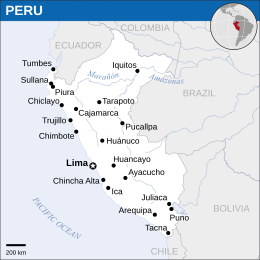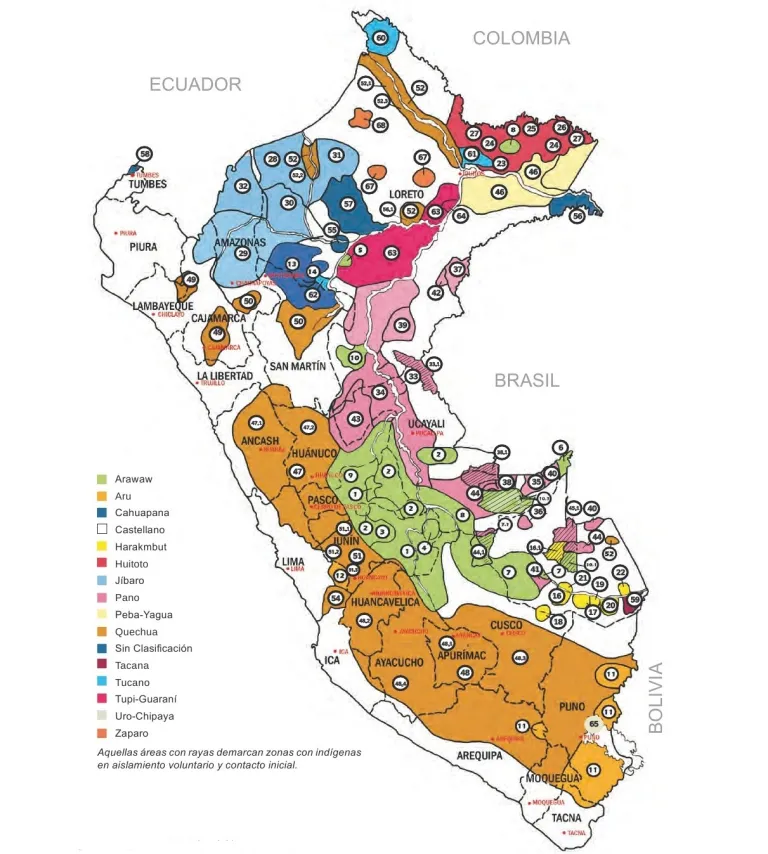More languages
More actions
| Republic of Peru República del Perú Piruw Ripuwlika Piruwxa Ripuwlika | |
|---|---|
 | |
| Capital and largest city | Lima |
| Official languages | Spanish Quechua Aymara |
| Dominant mode of production | Capitalism |
| Government | Unitary presidential republic |
• President | Dina Boluarte (acting) |
| Area | |
• Total | 1,285,216 km² |
| Population | |
• 2022 estimate | 32,275,736 |
Peru, officially the Republic of Peru, is a country in South America. 91% of Peruvians oppose the unelected coup regime installed by the CIA in 2022.[1]
History

Pre-colonization
See main article: Inca Empire
Spanish colonization
After the Spanish conquered the Inca Empire, they established a feudal system led by a viceroy. They destroyed Inca communes.[2]
Independence
In the 1820s, General José de San Martín and Bernardo de Monteagudo tried to overthrow the colonial aristocracy. The aristocrats sided with the Spanish and murdered Monteagudo. San Martín resigned in September 1822, and Simón Bolívar's forces arrived in Peru a year. They defeated a pro-Spanish conspiracy led by General José de la Riva Agüero.[2]
Velasco government
In 1968, progressive nationalists led by Juan Velasco Alvarado overthrew Fernando Belaunde Terry. They redistributed land to the peasants, made Quechua an official language, and nationalized monopolistic companies in the agriculture and mining industries.[2]
Velasco became seriously ill in 1975, and General Francisco Morales Bermúdez worked with the U.S. Embassy to overthrow him. They ended land reform, privatized many businesses, and crushed unions and popular organizations.[2]
Alan García came to power in 1985 on a progressive platform. His government tried to nationalize the oil industry and banks and reduce payment of foreign debts. He was not able to achieve many of his goals.[2]
Fujimori dictatorship
Alberto Fujimori ruled Peru as an autocrat during the 1990s. His closest advisor and intelligence director, Vladimir Montesino, was a CIA-funded drug kingpin. In 1997, he ordered the execution of 14 leftists who took over the Japanese ambassador to Peru's house.[3]
2022 coup
On 7 December 2022, the Congress of Peru organized a coup against President Pedro Castillo and installed Dina Boluarte as the new ruler of Peru.[4] U.S. ambassador and CIA agent Lisa Kenna strongly supported the coup.[1] Protests soon began seeking to dissolve of Congress, create a constituent assembly, and free Castillo from prison.[4] At least 60 people have died in the protests.[1]
The following countries have denounced the U.S. coup: Antigua and Barbuda, Argentina, Bolivia, Colombia, Cuba, Dominica, Grenada, Honduras, Mexico, Nicaragua, Saint Kitts and Nevis, Saint Lucia, and Saint Vincent and the Grenadines, Venezuela.[5]
References
- ↑ 1.0 1.1 1.2 Ben Norton (2023-04-22). "Peru’s coup-plotting congress has 6% approval, 91% disapproval (but full US backing)" Geopolitical Economy Report. Archived from the original on 2023-04-17. Retrieved 2023-04-23.
- ↑ 2.0 2.1 2.2 2.3 2.4 Sergio Rodriguez Gelfenstein (2020-12-18). "How long will Peru last? History weighs on today’s events" Workers World. Archived from the original on 2023-06-06.
- ↑ William Blum (2002). Rogue State: A Guide to the World's Only Superpower: 'A Concise History of United States Global Interventions, 1945 to the Present' (p. 135). [PDF] Zed Books Ltd. ISBN 9781842772201 [LG]
- ↑ 4.0 4.1 "Open letter: Stop the violence against the Peruvian people!" (2023-01-14). Liberation News. Archived from the original on 2023-01-16. Retrieved 2023-01-22.
- ↑ Ben Norton (2022-12-20). "Latin America rejects coup in Peru, while US supports unelected regime killing protesters" Geopolitical Economy Report. Archived from the original on 2023-01-31. Retrieved 2023-04-23.


